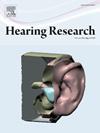Test-retest reliability of cortical auditory evoked potential indices of central auditory nervous system inhibition in people with and without tinnitus
IF 2.5
2区 医学
Q1 AUDIOLOGY & SPEECH-LANGUAGE PATHOLOGY
引用次数: 0
Abstract
The purpose of this study was to determine the test-retest reliability of cortical auditory evoked potentials (CAEPs) called onset-offset and sensory gating CAEPs. Further, this study compared test-retest reliability across people with and without tinnitus, across different stimulus frequencies (broadband noise, 0.25 kHz, 2 kHz, 8 kHz), and across different CAEP quantification approaches. The results of this study indicated that both sensory gating and onset-offset CAEPs were reliable, however reliability was maximized under certain experimental conditions. Specifically, people with tinnitus did exhibit differences in reliability for the sensory gating CAEP, although this did depend on the bandpass filter that was used to analyze the sensory gating response. Further, reliability was the strongest when the stimulus was a broadband noise as opposed to frequency-specific tones. Regarding CAEP quantification approach, reliability was the strongest for CAEP types that were larger in amplitude and robust CAEP measurements including peak-to-peak amplitude and total response area. Overall, these findings do indicate that both the sensory gating and onset-offset CAEP are reliable for people with and without tinnitus. However, certain experimental methods can be applied to maximize reliability such as using a broadband noise stimulus and/or measuring peak-to-peak amplitude and total response area.
伴有和不伴有耳鸣的人中枢听觉神经系统抑制的皮层听觉诱发电位指数的重测信度
本研究的目的是确定皮层听觉诱发电位(caep)的重测信度,即发病-偏移和感觉门控caep。此外,本研究比较了不同刺激频率(宽带噪声,0.25 kHz, 2 kHz, 8 kHz)和不同CAEP量化方法下耳鸣患者和非耳鸣患者的重测信度。本研究结果表明,感觉门控和发病偏移caep都是可靠的,但在一定的实验条件下,可靠性是最大的。具体来说,耳鸣患者在感觉门控CAEP的可靠性上确实表现出差异,尽管这确实取决于用于分析感觉门控反应的带通滤波器。此外,当刺激是宽带噪声而不是特定频率的音调时,可靠性最强。在CAEP量化方法中,对于振幅较大的CAEP类型和包括峰间振幅和总响应面积在内的稳健CAEP测量值,可靠性最强。总的来说,这些发现确实表明感觉门控和发病偏移CAEP对有或没有耳鸣的人都是可靠的。然而,可以采用某些实验方法来最大化可靠性,例如使用宽带噪声刺激和/或测量峰对峰幅度和总响应面积。
本文章由计算机程序翻译,如有差异,请以英文原文为准。
求助全文
约1分钟内获得全文
求助全文
来源期刊

Hearing Research
医学-耳鼻喉科学
CiteScore
5.30
自引率
14.30%
发文量
163
审稿时长
75 days
期刊介绍:
The aim of the journal is to provide a forum for papers concerned with basic peripheral and central auditory mechanisms. Emphasis is on experimental and clinical studies, but theoretical and methodological papers will also be considered. The journal publishes original research papers, review and mini- review articles, rapid communications, method/protocol and perspective articles.
Papers submitted should deal with auditory anatomy, physiology, psychophysics, imaging, modeling and behavioural studies in animals and humans, as well as hearing aids and cochlear implants. Papers dealing with the vestibular system are also considered for publication. Papers on comparative aspects of hearing and on effects of drugs and environmental contaminants on hearing function will also be considered. Clinical papers will be accepted when they contribute to the understanding of normal and pathological hearing functions.
 求助内容:
求助内容: 应助结果提醒方式:
应助结果提醒方式:


